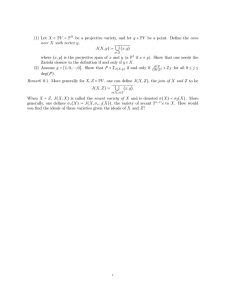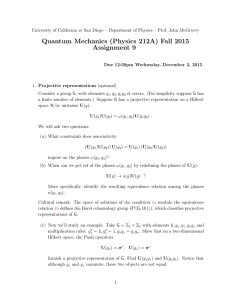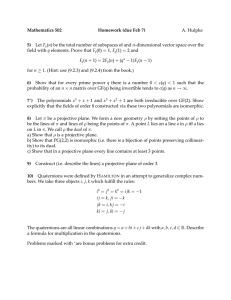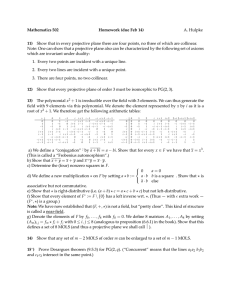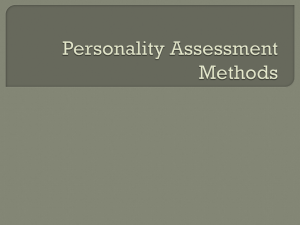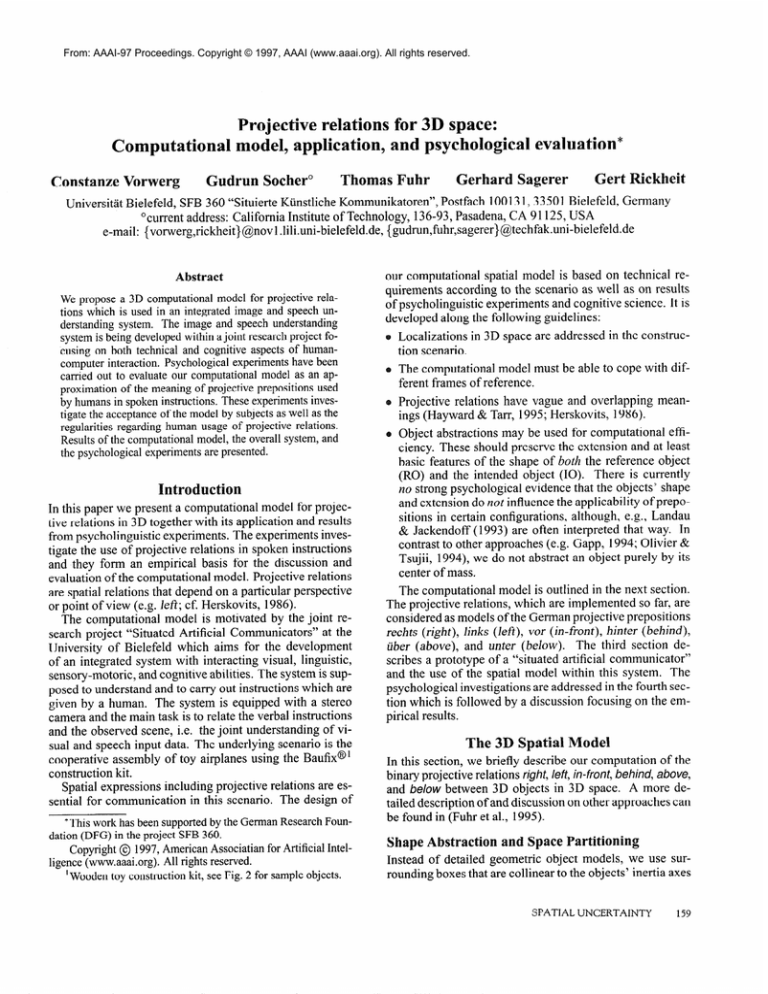
From: AAAI-97 Proceedings. Copyright © 1997, AAAI (www.aaai.org). All rights reserved.
Computational
Constanze Vorwerg
Projective relations for 3D space:
model, application, and psychological evaluation*
Gudrun Socher’
Thomas Fuhr
Gerhard Sagerer
Gert Rickheit
Universitat Bielefeld, SFB 360 “Situierte Ktinstliche Kommunikatoren”, Postfach 10013 I,33501 Bielefeld, Germany
Ocurrent address: California Institute of Technology, 136-93, Pasadena, CA 9 1125, USA
e-mail: {vorwerg,rickheit}@novl
.lili.uni-bielefeld.de, {gudrun,fuhr,sagerer}@techfak.uni-bielefeld.de
Abstract
We propose a 3D computational model for projective relations which is used in an integrated image and speech understanding system. The image and speech understanding
system is being developed within a joint research project focusing on both technical and cognitive aspects of humancomputer interaction, Psychological experiments have been
carried out to evaluate our computational model as an approximation of the meaning of projective prepositions used
by humans in spoken instructions. These experiments investigate the acceptance of the model by subjects as well as the
regularities regarding human usage of projective relations.
Results of the computational model, the overall system, and
the psychological experiments are presented.
Introduction
In this paper we present a computational model for projective relations in 3D together with its application and results
from psycholinguistic experiments. The experiments investigate the use of projective relations in spoken instructions
and they form an empirical basis for the discussion and
evaluation of the computational model. Projective relations
are spatial relations that depend on a particular perspective
or point of view (e.g. left; cf. Herskovits, 1986).
The computational model is motivated by the joint research project “Situated Artificial Communicators” at the
University of Bielefeld which aims for the development
of an integrated system with interacting visual, linguistic,
sensory-motoric, and cognitive abilities. The system is supposed to understand and to carry out instructions which are
given by a human. The system is equipped with a stereo
camera and the main task is to relate the verbal instructions
and the observed scene, i.e. the joint understanding of visual and speech input data. The underlying scenario is the
cooperative assembly of toy airplanes using the Baufix@ ’
construction kit.
Spatial expressions including projective relations are essential for communication in this scenario. The design of
*This work has been supported by the German Research Foundation (DFG) in the project SFB 360.
Copyright @ 1997, American Associatian for Artificial Intelligence (www.aaai.org). All rights reserved.
i Wooden toy construction kit, see Fig. 2 for sample objects.
our computational spatial model is based on technical requirements according to the scenario as well as on results
of psycholinguistic experiments and cognitive science. It is
developed along the following guidelines:
Localizations in 3D space are addressed in the construction scenario.
The computational model must be able to cope with different frames of reference.
Projective relations have vague and overlapping meanings (Hayward & Tart-, 1995; Herskovits, 1986).
Object abstractions may be used for computational efficiency. These should preserve the extension and at least
basic features of the shape of both the reference object
(RO) and the intended object (IO). There is currently
no strong psychological evidence that the objects’ shape
and extension do not influence the applicability of prepositions in certain configurations, although, e.g., Landau
& Jackendoff (1993) are often interpreted that way. In
contrast to other approaches (e.g. Gapp, 1994; Olivier &
Tsujii, 1994), we do not abstract an object purely by its
center of mass.
The computational model is outlined in the next section.
The projective relations, which are implemented so far, are
considered as models of the German projective prepositions
recks (right), links (left), vor (in-front), hinter (behind),
iiber (above), and unter (below). The third section describes a prototype of a “situated artificial communicator”
and the use of the spatial model within this system. The
psychological investigations are addressed in the fourth section which is followed by a discussion focusing on the empirical results.
In this section, we briefly describe our computation of the
binary projective relations right, left, in-front, behind, above,
and below between 3D objects in 3D space. A more detailed description of and discussion on other approaches can
be found in (Fuhr et al., 1995).
Shape Abstraction
and Space Partitioning
Instead of detailed geometric object models, we use surrounding boxes that are collinear to the objects’ inertia axes
SPATIAL
UNCERTAINTY
159
Reference-dependent
l
Reference-independent
degree
of
applicability
Projective
Relations
6:
degrees qf containment
= 0.25
4
+
I .O
x
0.0
+
x
0.63
0.5
+
x 0.37
0.75 x 0.0
Definitions
Meaning
of Projective
Relations
combination
* acceptance
relations:
o degree of
accordance
degrees of‘ accordance
;,Ro(IO,RO)
iI7
IO intersects A ViRo
* degree of containment
y:
Object
relative part ~$10 j.
volume in A v
a:
direction vector
Abstractions
RO
dtTlOtIO~l
H
reference vector
Acceptance Volumes (AV)
& Direction Vectors
AV
AV
AV
Stereo Images
--)
Fig. 1: Computation of scored projective relations for object pairs: The principles of the computation are demonstrated for 2D objects in
2D space. An object-specific partitioning of 2D space into 12 acceptance volumes is chosen. As an example the generation of the relation
behind is shown for the objects IO and RO w.r.t. the reference frame reJ:
(Abella & Kender, 1993) as abstractions. Although this is
a rough shape abstraction, it is sufficient to investigate the
influence of the objects’ shape and extension to the use of
projective prepositions. It must be pointed out that the principal computational structure of our approach is not bound
to this sort of object abstractions. Other polyhedra and even
object-specific
polyhedra
could be used as well.
For sim-
plicity, we currently use the same kinds of boxes for all
kind of objects in the scenario. Throughout this section, we
use “object” as a synonym for the object’s box.
A finite number of acceptance volumes AV,O is associated with each object 0. These are infinite open polyhedra
bound to the sides, edges, and corners of the object. They
partition
the 3D space surrounding
the object.
A direction
vector d( AV,O) corresponds to each acceptance volume. It
roughly models the direction to which an acceptance volume extends in space. The object-specific partitioning is
motivated by the assumption that the object itself may influence the way the surrounding space is perceived inde-
pendently of specific reference frames2.
Generation
of Relations
from Objects
The computation of relations from objects is a two-layered
process. In the first layer, a reference-independent spatial representation is computed. Each acceptance volume
induces a binary acceptance relation ro that expresses
whether an object P intersects with AVio. Acceptance volumes are scored by calculating the corresponding degree of
containment:
wol (P n AVio)
Yuv?)
=
woZ(P)
*
2The discrete partitioning is also motivated by the following
requirement: The computational model shall allow us to infer possible image regions for the depiction of the IO with respect to a
given RO under a given reference frame, that can be exploited by
an object recognition component. However, we cannot discuss
this issue in this paper (see Fuhr et al., 1995).
160
AUTOMATED
REASONING
Thus, the relation between two objects P and 0 can be
reference-independently expressed by a set of scored acceptance relation symbols with non-zero degree.
Furthermore, reference-dependent meaning d@kitions
of relations rel w.r.t. to certain ROs and a given reference
frame ref= {wright, cleft, . . . , raboVe} are also calculated in
the first layer. The actual reference frame refis assumed to
be provided by other linguistic or cognitive components of
our artificial communicator. deflref,re/,RO) is given as the
set of the symbols of all acceptance relations rF” whose direction vector differs less than 90” from the corresponding
reference vector r rel. The membership of an acceptance
relation (symbol) to a meaning definition is scored by its
degree of accordance:
a(ref, rel,r”O)
arccos(d(AV,Ro)
= 1 - 2.
- ~~~1)
lr
These two scored symbolic reference-independent and
reference-dependent descriptions are the basis for the computation of reference-dependent relational expressions for
IO-R0 pairs in the second layer. The basic idea is, that the
relation rel is applicable for an IO-R0 pair w.r.t. a reference frame refif at least one of the acceptance relations in
def(ref,re/,RO) holds between IO and RO. Again the degree
of applicability S(ref , rel, IO, RO) of rel varies gradually:
G(ref,
rel, IO, RO) = xa(ref,
rel, TR’) . ~(10, rR”).
rP0
def (re;,
t-2,
RO)
Fig. 1 illustrates the steps of this computation. For easier visualization the steps are shown for 2D objects in 2D
space. Furthermore, the table in Fig. 2 contains the relations and their applicability degrees computed for the scene
shown in the image. The reference frame is assumed to
be deictic and corresponding with the cameras’ view of
the scene. The table demonstrates that the results are very
promising keeping in mind that they have been computed
INSTRUCTOR
‘v
Speech
Understanding
1IO I RO II left I riaht I above 1below ( behind
I-
I
I in-front
1
I
Fig. 3: Overview of the prototype of a situated artzjicial communicator: The speech and image understanding modules derive
qualitative descriptions from acoustic and visual input data. The
understanding processes work both data-driven and model-driven.
Object Identification
Fig. 2: Example of the projective relations and their degrees of
applicability computed for the numbered objects from the scene
degree per
shown in the image: The maximum applicability
RO-IO pair is highlighted in bold print. The chosen reference
frame takes the position of the cameras as vantage point to allow
for an easy verification of the results from the image of the scene.
from slightly erroneous 3D object poses reconstructed from
real stereo image data.
Due to the fuzziness of our relation model several relations are usually applicable between an object pair. This
points to another important issue: What are the relations
most relevant to select? Obviously, nobody would specify the relation between an object pair using all projective
prepositions. The table shows that in many cases a maximum decision yields good results. However, in ambiguous
cases two relations might be chosen. We will return to this
aspect later.
A Situated Artificial
Communicator
Fig. 3 sketches our prototype of a “situated artificial com-
municator.” It is a speech and image understanding system
with the objective to mutually restrict the understanding
processes through (intermediate) results from the respective
other source of data. There are a number of other encouraging approaches towards the integration of vision and language (e.g. Nagel, 1988; Wahlster, 1989; MC Kevitt, 1994).
But most of this work concentrates either on the generation
of scene descriptions from images or on the visualization of
spoken phrases. In our system, the speech and image understanding modules extract qualitative descriptions from the
speech and image data, respectively. A inference module,
identifies the the intended object(s) and/or infers mutual restrictions for the understanding processes. The inference
machine operates on the qualitative descriptions.
Objects in the scene are referred to by elliptic or complete
noun groups, and possibly by projective terms. With the
results from scene interpretation, utterances like “take the
one behind the bar” can be sufficient to find the intended
object. The object identification in our system is based on a
common, qualitative description of the object’s type, colov,
size, shape, and of projective relations. More details on
the object recognition, color classification. and the size and
shape assignment can be found in Socher et al. (1996). The
instructions are given in real speech and the speech understanding is described in Socher & Naeve (1996).
All qualitative features are represented by vectorial random variables. For each symbol of a feature space (e.g.
color or projective relations) the vectorial random variables
contain a fuzzy degree of applicability of that symbol. The
results of the computation of projective relations are used
directly. The projective relation between two objects is thus
specified by all computed projective relations and their degrees of applicability. This representation has the following
advantages:
e Overlapping meanings and concurring hypotheses can be
represented.
o The degree of applicability for each symbol of a feature
space is captured. No irreversible, strict decision has to
be made for the qualitative value of a feature in an early
stage of the understanding processes.
e Object specifications in instructions can be of a wide variety. Using an inference machine, the understanding of
object specifications is rather flexible according to which
kind of features are named. Even partially false specifications can be handled.
The inference machine is based on a Bayesian network
(Pearl, 1988). Nodes of the Bayesian network represent
the features type, color, size, shape, and projective relation which result from speech understanding as well as the
scene, the objects detected in the images, and the computed
projective relations. The root node of this simple polytree network represents the identified object(s). The joint
SPATIAL
UNCERTAINTY
161
probability for each object of being intended is estimated
through propagation of the evidences in the network. If
evidences are missing, restrictions are inferred. The conditional probability tables which are associated with the
links in the Bayesian network are estimated based on confusion matrices obtained by the recognition procedures and
by psycholinguistic experiments. Prior knowledge of the
construction task is also incorporated.
Results
It is difficult to evaluate a complex system due to the system
output is affected by various decisions, computations, and
errors made at all processing steps.
For a first end-to-end evaluation of our system, we
recorded spontaneous utterances produced by 10 naive
users. Subjects had to refer to randomly selected objects
in 11 different scenes. In each turn, an image of one of
the scenes with one marked object was presented on a computer screen. The subject’s utterance that is supposed to
refer to the marked object was recorded. The first line in
Table 1 shows the system results for 270 utterances. For
this experiment the transcriptions of the spoken object references were used in order to avoid speech recognition errors here. Object identifications that contain the referred
object are considered correct even when the system chose
several objects that corresponded to the subject’s utterance.
The selection made by the system is unique for only 27%
of the utterances.
I input source
no projective rel.
projective rel.
false
a
195 (72%)
66 (74%)
80 (27%)
55 (62%)
16 (6%)
13 (15%)
I nothing I
59 (22%)
10 (11%)
Table 1: System results for 270 utterances containing no projective relations compared to 89 utterances of subjects that use projective relations to name the intended object.
In a second experiment, 6 subjects were explicitly asked
to use projective relations when referring to objects in 6 different scenes. The second line in Table 1 shows the system
output for these utterances. Here, the number of uniquely
and correctly identified objects (62%) is much higher than
without projective relations. Projective relations significantly improve the accuracy for exact localizations. For this
experiment, judgment criteria were severer than for the first
one. While in the first case, any object with the same type,
color, size, or shape could be selected, here the system’s
task was to find exactly the intended object. Therefore, the
number of false identifications is higher in the second experiment. Most of the false identifications are due to discrepancies between the computation of projective relations
and the use of projective relations by the subjects.
Empirical
Psycholinguistic Results
For an empirical evaluation of the computational model,
two controlled psychological experiments were run. Subjects either generated spatial terms for describing the spatial
relationship between object pairs or rated the applicability
162
AUTOMATED
REASONING
of spatial relations that were computed on the basis of the
spatial model. Whereas most research in spatial cognition
has focused on the canonical directions constituting the spatial framework using reference objects in canonical orientations (e.g., Carlson-Radvansky & Irwin, 1993; Hayward &
Tar-r, 1995), we are especially interested in the organization
of visual space in non-canonical spatial configurations.
In both experiments, distance, orientation of the reference object, and position of the intended object (according
to the computed acceptance volumes) systematically varied. To avoid conflicting perspectives, only reference and
intended objects with no intrinsic parts were used. All objects were located on one horizontal plane; the use of the
horizontal projective terms rechts (right), links (left), binter (behind), and vor (in-front) was investigated. Stimuli
in all experiments consisted of two objects, one of which
was always in the center of the picture (the reference object: a bar) in one of four different orientations, and the
other (the intended object: a cube), at one of 24 positions
around the reference object and at one of three different distances (see Fig. 4). The four orientations used included two
orientations collinear with the reference system (one horizontal, see Fig. 4a, and one sagittal, see Fig. 4b) and two
rotated orientations where the inertia axes deviate by 45”
(see Fig. 4c,d). Stimuli were displayed at a Silicon Graphics Workstation using a pair of Crystal Eyes Stereo Glasses.
Before running these two experiments, we had carried
out a preliminary study in which subjects (N=36) had
named these spatial relations in free speech in order to find
out, among other things, what namings would be used. In
99.5% of the utterances, projective prepositions or adverbs
were used. In German, two prepositions can be syntactically combined (e.g., links vor). Those combined namings
were used in 6 1.5% of the utterances.
In Experiment 1, 40 German native speakers rated the
applicability of projective prepositions that represented the
relation judged maximally by the system for the configurations described above; two (equally judged) were combined when no single relation was judged best. To avoid
answer bias and to have a reference system in which to see
the results, a same number of distracters (“wrong answers”)
was introduced. Distracters had been constructed systematically by adding a second either neighboring or contrasting
relation, leaving out the best or second best applicable relation, or substituting it by a neighboring or contrasting relation. The displayed relation naming could be rated from 0
to 1 by the subjects using a sliding scale.
Results show a generally high acceptance of the computed relations (,Q = 0.90, o2 = 0.17; cf. distracters:
,Q = 0.34, o2 = 0.39). For some distracters in some positions, we find distracters rated the same as the system output (in the case of combination with the second applicable
relation). A Multiple Analysis of Variance (ANOVA) reveals a significant influence of orientation and distance on
the rating of system output with no interaction between the
two factors. By post hoc mean comparisons, we find that
the largest distance is rated slightly (but significantly) better and that a sag&al orientation of the reference object is
(4
left &
behind
(b)
left&
behind
@ %@ q
q
$3
(b)
horizontal
behind
z&g I
?g$
horizontal,
45’
right &
right &
behind
eft
Cc)
behind
behind
positions
of IO
forced-choice:
left & behind
SySb3ll
behind
OUtpUt:
positions
behind
-
of IO
right & behind
- - -
Fig. 5: Exemplary comparison of applicability
degrees computed by the system and relative frequency of used prepositions
in the forced-choice experiment (experiment 2): (a) horizontal
orientation (see Fig. 4a) (b) horizontal orientation rotated by 45”
(see Fig. 4c)
3
I3
5
6
4
Fig. 4: (a) to (d) Preposition chosen most often in experiment 2
for each configuration used (winner-takes-all):
A surrounding line
indicates that two namings have been chosen equally often.
(e) and (f) Exemplary results of the Kohsnen Maps for the
collinear and the rotated conditions. The broken lines enclose
those positions belonging to one cluster. Numbers indicate positions grouped together for an ANOVA.
rated better than a horizontal one, which again is rated better than the two rotated orientations.
The ANOVA yielded
a significant influence ofposition
on the rating as well. To
investigate this dependency in detail, we subdivided the 24
positions into 6 position groups according to the six positions contained in each quadrant around the reference object. In the collinear conditions, we find that the nearer the
position groups are to the left-right and in-front-behind
axes
(l/2 > 6 > 3/4 > 5; see Fig. 4e) the better they are rated.
In the rotated conditions some position groups are rated better than others as well (5 > 6/3 > l/4 > 2; see Fig. 4f).
Altogether, subjects’ ratings show a significant correlation
with the degrees of applicability computed by the system.
In Experiment 2,20 German native speakers themselves
named the direction relations, choosing from a given set
of projective prepositions (on buttons) the one that fitted
the displayed spatial configuration best. The given answer
choice included right, left, behind, in-front, below, above
and their respective combinations.
The results of experiment 2 show again that subjects tend
to use combined direction terms; single direction expressions are seemingly used only in unambiguous cases. As for
the collinear reference objects (see Fig. 4a,b), the positions
in which most subjects use single expressions are located
centrally within the computed relation applicability areas.
Regarding the rotated reference objects (see Fig. 4c,d), two
combined direction terms are used significantly more often depending on the direction of the reference object (e.g.,
left& in-front and right& behind in the case of orientation
(c); see Fig. 5b) indicating a stronger influence of the reference system on the partitioning of space. Otherwise (when
surrounding space is partitioned exclusively by the reference object) we would expect a symmetric distribution of
spatial terms.
A more detailed analysis shows the overlap of applicability regions when taking into account the distribution
of different projective terms over the positions occupied
by the intended objects. For the collinear orientations of
the reference object, the peaks in frequency of the naming of a certain preposition correspond well with those in
the computed applicability degree of the corresponding relation (see Fig 5a). Regarding the rotated reference objects,
we find a small systematic shift of the empirical peak and a
disproportion of certain combined prepositions in the same
way as in the winner-takes-all-results (see Fig. 5b). A clustering of the data obtained by means of a Self-Organizing
Kohonen Map reveals that only for the non-rotated reference objects is it possible to find eight clear-cut applicability areas of the four prepositions and their respective combinations. Whereas it is more difficult to distinguish applicability regions in the case of rotated reference objects.
This result is supported by an Analysis of Variance using
the information entropy obtained for each distance and ROs
orientation. There is a significantly greater entropy (from
what uncertainty follows) in the case of rotated reference
objects as well as in the case of the nearest distance (with
no interactions between the two factors).
SPATIAL
UNCERTAINTY
163
Discussion
The generally high rating of the system’s output shows the
usability of the spatial computational model. In general,
we find a correspondence between the central tendencies of
the subjects’ namings and the system’s output, particularly
good for the collinear reference objects.
Production data, especially the greater entropy found for
the rotated reference objects (experiment 2) can account
for the slightly smaller rating of these orientations in experiment 1. There is obviously more uncertainties about
how to name projective relations in the case of rotated reference objects. This interpretation is supported by results of
Kohonen Maps which show that subjects have no clear-cut
applicability regions for the rotated reference objects.
In accordance with results reported in literature, our data
provide strong evidence for the graded validity of projective
relations and their overlap. The computational model takes
this into account.
The empirical findings provide evidence for the assumption of the computational model that the reference object’s extensions in space (Vorwerg, in prep.) as well as its
rotation must be taken into account. For a rotated reference object, there is obviously a conflict between the object’s axes and the reference system’s axes, which seems
to be resolved by a kind of trade-off resulting in using the
nearest part (corner or edge) of the reference object as a
reference point. Subjects’ data can be interpreted as using the axes imposed by the reference system, but shifting
those half-line axes (left, right, in-front, and behind) towards
the nearest part of the reference object. The computational
model’s rotation of acceptance volumes may serve as an
approximation for these cognitive processes in most positions. In some positions around rotated reference objects
however, the assumed half-line axes cross acceptance volumes resulting in a discrepancy between computed projective relations and terms used by the subjects. These cases
can account for the false identifications found in the testing
of the artificial communicator system and could possibly be
compensated for by using a non-linear and non-symmetric
judgment function for the degree of accordance.
Subjects’ frequent use of combined direction terms,
which might in part be due to this special syntactic possibility in German, can easily be fitted into the computational
model by changing the criterion according to which two relations are to be combined (e.g. take all relations which are
assessedbetter than 0.3; in the case of two, combine them).
The fact that several positions exist where subjects rated
combined and single terms equally indicates some flexibility in assigning spatial relations. Regarding the empirical
evaluation of computational models, it must be taken into
consideration that the uncertainty of subjects in naming a
projective relation has some influence on the applicability
rating of presented projective terms.
Conclusion
In this paper, we presented a computational model for
projective relations that is used in a system for advanced
human-computer interaction. In this context, psychological
164
AUTOMATED
REASONING
and cognitive aspects of human localization are of great interest. We carried out experiments investigating the use of
projective relations by humans in our scenario. The experiments included an empirical evaluation of our system.
The experiments show a high acceptance of the computation of the projective relations by humans. They also show
differences between the human production of projective relations and their computation by our model. Further investigations will concentrate on the use of the cognitive findings
to improve the computational model. The emphasis will
be placed on achieving a good trade-off between technical
benefits (like the two-layered structuring and the existence
of a reference-independent spatial representation) and cognitive adequacy of the model.
eferences
Abella, A. & Kender, J. (1993). Qualitatively Describing Objects Using Spatial Prepositions. In Proc. of AAAI-93, pp.
536540.
Carlson-Radvansky, L. & Irwin, D. (1993). Frames of reference
in vision and language: Where is above? Cognition 46,
223-244.
Fuhr, T., Socher, G., Scheering, C., & Sagerer, G. (1995).
A three-dimensional
spatial model for the interpretation
of image data. In P. L. Olivier (Ed.), IJCAI-9.5 Worlcshop
on Representation and Processing of Spatial Expressions,
Montreal, pp. 93-l 02.
Gapp, K.-P. (1994). Basic Meanings of Spatial Relations:
Computation and Evaluation in 3D space. In Proc. qf
AAAI-94, pp. 1393-1398.
Hayward, W. & Tar-r, M. (1995). Spatial language and spatial
representation. Cognition 5.5, 39-84.
Herskovits, A. (1986). Language and spatial cognition. Cambridge, Mass.: Cambridge University Press.
Landau, B. & Jackendoff, R. (1993). “What” and “where”
in spatial language and spatial cognition. Behavioral and
Brain Sciences 16,2 17-265.
MC Kevitt, P. (Ed.) (1994). Special Issue on Integration qf’NatUral Language and &ion Processing, Volume 8 of Art$cial Intelligence Volume. Kluwer Academic Publishers.
Nagel, H. (1988). From image sequences towards conceptual
descriptions. Image and V&ion Computing 6(2), 59-74.
Olivier, P. & Tsujii, J.-I. (1994). Quantitative Perceptual Representation of Prepositional Semantics. Art$cial InteIligence
Review Special Issue of Natural Language and Vision Processing 8(2-3), 5566.
Pearl, J. (1988). Probabilistic Reasoning in Intelligent xvstems:
Networks of Plausible Inference. San Mateo, CA: Morgan
Kaufmann Publishers.
Socher, G. & Naeve, U. (1996). A Knowledge-based
System
Integrating Speech and Image Understanding - Manual
Version 1.O. Report 95/15 - Situierte Ktinstliche Kommunikatoren, SFB 360, Universitat Bielefeld.
Socher, G., Sagerer, G., Kummert, F., & Fuhr, T. (1996). Talking About 3D Scenes: Integration of Image and Speech
Understanding in a Hybrid Distributed System. In Znternational Conference on Image Processing (ICIP-96), Lausanne, pp. 18A2.
Vorwerg, C. (in preparation). Categorization of spatial relations.
Wahlster, W. (1989). One Word says More Than a Thousand
Pictures. On the Automatic Verbalization of the Results of
Image Sequence Analysis Systems. Computers and Artzjicial Intelligence 8,479-492.


